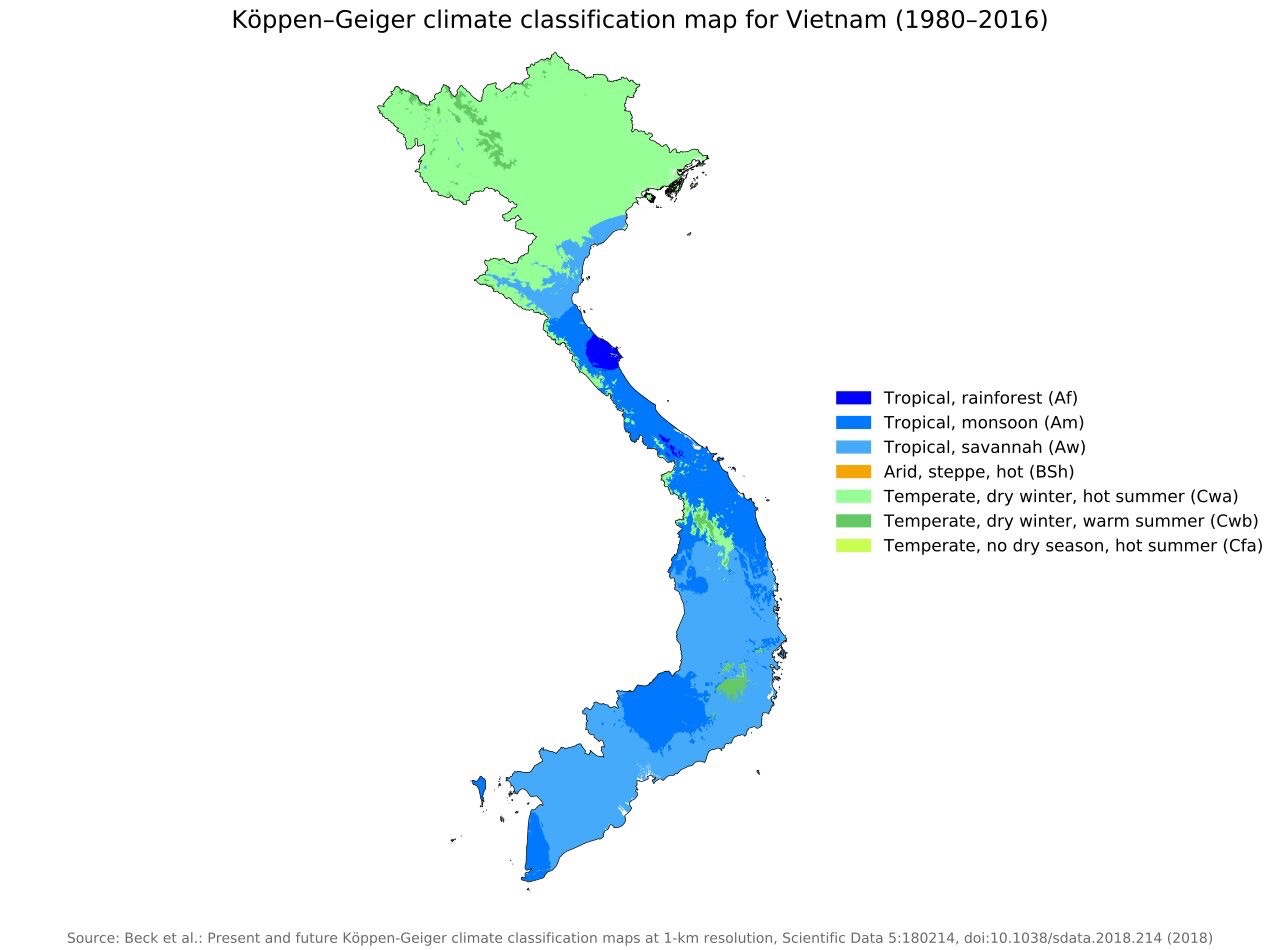Understanding Vietnam Climate is crucial for making the most of your trip to this enchanting travel destination, gaining popularity for its captivating cultural heritage and diverse landscapes. Ranging from tropical in the south to temperate in the north, Vietnam Climate plays a pivotal role in shaping your experience. Let’s delve into the seasonal nuances and discover the best times to visit, allowing you to plan a personalized and unforgettable experience.
What is Vietnam Climate?
Vietnam features both tropical and temperate climate zones, influenced by the annual monsoon. The monsoon circulations bring significant rainfall, occurring from May to October in the north and south, and from September to January in central regions.
In the north, summers average 22–27.5°C, winters 15–20°C. Southern regions show a narrower range, with summers at 28–29°C and winters at 26–27°C.
El Niño Southern Oscillation (ENSO) further impacts Vietnam’s climate, leading to intricate shifts in rainfall and temperature patterns at a sub-national level. Understanding these nuances is essential for a comprehensive grasp of Vietnam’s climatic conditions.

Overview of Vietnam Climate
Northside: Embracing Seasonal Contrasts
Northern Vietnam, encompassing Hanoi and the scenic Sapa, experiences a distinct seasonal contrast. Defined by a cooler winter season (November to April) and a warmer summer season (May to October), the northside offers a diverse climate. Travelers can escape the summer heat in the picturesque highlands while embracing the crisp winter air in Hanoi.
Understanding the nuances of the north’s climate is crucial for planning activities. The winter season provides an ideal backdrop for exploring cultural sites and trekking adventures, while the warmer months offer vibrant landscapes and outdoor pursuits. This climatic diversity enhances the allure of northern Vietnam for those seeking a multifaceted travel experience.
Southside: Tropics and Tranquility
Southern Vietnam, including Ho Chi Minh City, thrives in a tropical climate marked by consistency. The region boasts a dry season (November to April) and a wet season (May to October). Embracing warmth year-round, the southside offers travelers a chance to explore its vibrant culture and stunning landscapes without the seasonal extremes.

In the south, seasonal considerations play a pivotal role in planning activities. The dry season is ideal for beach retreats, exploring bustling city life, and indulging in outdoor adventures. Understanding the climatic zones in coastal areas versus urban centers ensures that travelers can curate their itinerary to match their preferences, from relaxing on pristine beaches to navigating lively city streets.
Central Vietnam: Balancing Highlands and Coastal Charms
Central Vietnam, including Da Nang and Hoi An, strikes a balance between the contrasting climates of the north and south. The region experiences a tropical climate with distinct wet (September to December) and dry (January to August) seasons. This climatic equilibrium creates an inviting environment for diverse travel experiences.

Understanding the climatic variations in central Vietnam guides travelers in choosing the optimal time for exploration. From exploring ancient architecture in the dry season to appreciating lush landscapes during the wet season, central Vietnam offers a harmonious blend of natural beauty and cultural richness. Exploring these climatic nuances ensures that every journey through central Vietnam is a seamless and enriching experience.
Best Time to Visit and Weather Preferences
Optimal Times for Traveling to Vietnam
Vietnam offers a diverse climate, providing a year-round canvas of experiences for travelers. Understanding the best times to visit is key to maximizing your journey.
Ideal months vary across the country. For milder temperatures and minimal rainfall, consider November to April. This period is perfect for exploring Hanoi’s cultural treasures or cruising the enchanting waters of Ha Long Bay.

In January and December, Vietnam experiences cool temperatures, ideal for northern escapades to Sapa or festive experiences during Tet, the Vietnamese New Year.
April beckons pleasant weather in Central Vietnam, including Da Nang and Hoi An, suitable for beach retreats and cultural explorations.
Heading south in November? Saigon, or Ho Chi Minh City, enjoys a dry climate, creating an excellent backdrop for urban adventures and historical explorations.
For a different vibe, explore Vietnam in July, embracing the vibrant atmosphere during festivals and cultural events, especially in the bustling streets of Hanoi.
Personal Weather Preferences and Planning Activities
Tailoring plans based on personal weather preferences ensures a customized and enjoyable journey. If you prefer warmth, explore the southern charms of Ho Chi Minh City, Nha Trang’s beaches, or the bustling Mekong Delta.
To avoid extreme conditions, be mindful of the wet season (May to October) when planning outdoor activities. However, the rain adds a unique charm to destinations like Hoi An, where lantern-lit streets come alive in the drizzle.
Local experiences thrive on climate considerations. Visit floating markets in the Mekong Delta during the dry season for an authentic glimpse of daily life. Meanwhile, northern mountainous regions offer distinct cultural encounters, best enjoyed in milder weather.
Understanding Vietnam’s varied climate ensures that whether navigating the historic streets of Hanoi, trekking the terraced fields of Sapa, or immersing yourself in Saigon’s vibrant street life, your journey aligns seamlessly with your weather preferences and chosen activities.

Conclusion
In summary, understanding Vietnam’s diverse climate is vital for a well-rounded travel experience. Consider the seasonal nuances and optimal times to visit. Plan wisely to unlock the full spectrum of Vietnam’s beauty. Your journey awaits—be prepared for a personalized and unforgettable adventure.
Frequently Asked Questions
What is the climate in Vietnam?
Vietnam’s climate is diverse, ranging from tropical in the south to temperate in the north. It experiences distinct wet (May to October) and dry (November to April) seasons.
How is the climate in Vietnam?
The climate varies regionally. The north has four seasons, the central region leans tropical, and the south remains warm year-round.
Is Vietnam hot or cold?
Both. Southern regions are typically hot, while the north experiences cooler temperatures, especially in winter.
Are there 4 seasons in Vietnam?
Yes, the north has four seasons: spring, summer, autumn, and winter. The south experiences wet and dry seasons, and the central region has a mix.
What is the weather like in Vietnam year-round?
It varies. The south is warm and humid, the north has distinct seasons, and the central region has a blend of both.
Why is Vietnam humid?
Vietnam’s humidity is influenced by its tropical climate and proximity to the sea. The country experiences high humidity, especially during the wet season.


Related Posts
Vietnam Motorbike Adventures: The Ultimate Guide
With its breathtaking landscapes, rich cultural heritage, and vibrant local experiences, Vietnam offers an unforgettable adventure for motorbike enthusiasts. Discover hidden gems, meet friendly locals, and create lasting memories as you explore diverse terrains and immerse yourself in the heart of Vietnam. Why Choose a Motorbike Adventure in Vietnam? Freedom and Flexibility If you love […]
Experience the Living Conditions in Cu Chi Tunnels: Unbelievable!
Cu Chi Tunnels served as the living quarters for soldiers and civilians during Vietnam’s resistance against France and America. Today, this remarkable site stands as a symbol of perseverance, determination, and resilience during one of the most challenging periods in Vietnamese history. Discover the living conditions in Cu Chi Tunnels with Joy Journeys in the […]
Vietnam Fish Cake: A Culinary Delight
Vietnam fish cake, known for its delicious and diverse flavors, is a favorite among tourists looking to explore authentic Vietnamese cuisine. From the crispy, golden-brown texture of fried fish cakes to the fragrant, herb-infused variations found in regional specialties, these savory delights offer a true taste of Vietnam. In this article, we will take you […]